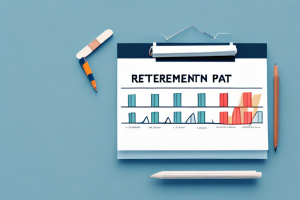Saving for retirement is an important financial goal that requires careful planning and consideration. Many individuals aim to have a significant amount saved by the time they reach age 55, as it is often seen as a milestone in retirement planning. But how much should you have saved by this age? In this article, we will explore this question and provide detailed insights into various factors that should be considered when determining your retirement savings goals.
Why is it important to save for retirement?
Saving for retirement is crucial for several reasons. Firstly, it provides financial security and peace of mind during your golden years. It allows you to maintain your desired lifestyle and covers essential expenses such as housing, healthcare, and leisure activities. Additionally, having sufficient retirement savings enables you to cope with unexpected expenses or emergencies that may arise in the later stages of life.
Secondly, saving for retirement is essential because it allows your investments to grow over time. By starting early and contributing regularly, you can take advantage of the power of compound interest and potentially generate significant wealth for your retirement years.
The importance of starting early with retirement savings
One key factor to consider when determining how much you should have saved for retirement by age 55 is the importance of starting early. The earlier you begin saving and investing for retirement, the more time your money has to grow and compound.
Starting early also allows you to take advantage of long-term investment strategies that may offer higher returns. By putting your money to work for a longer period, you may be able to achieve your retirement savings goals more easily and enjoy greater financial security in the future.
Factors to consider when determining retirement savings goals
When determining how much you should have saved for retirement by age 55, it is crucial to consider several factors that can impact your savings goals. These factors include:
Current age: Your current age plays a significant role in setting retirement savings goals. The earlier you start, the more time you have to save and benefit from compound interest.
Retirement age: The age at which you plan to retire is also a factor to consider. If you plan to retire early, you may need to save a larger amount to cover a longer retirement period.
Life expectancy: Life expectancy is another crucial consideration, as it affects the number of years your retirement savings will need to support you.
Desired retirement lifestyle: The type of lifestyle you envision for your retirement also influences your savings goals. If you wish to travel extensively or pursue expensive hobbies, you may need to save more to support these activities.
Expected retirement expenses: Estimating your projected retirement expenses is crucial when determining how much you should have saved by age 55. Consider factors such as housing costs, healthcare expenses, and daily living expenses.
Average retirement savings by age 55: What are the benchmarks?
While there is no one-size-fits-all answer to how much you should have saved for retirement by age 55, benchmarks can provide some guidance. According to financial experts, a general rule of thumb is to have at least three to five times your annual salary saved by age 55.
However, it’s important to note that everyone’s financial situation and retirement goals differ. Some individuals may have smaller savings goals due to pension plans, inheritances, or other sources of income, while others may need to save more due to various factors.
Assessing your current financial situation and projected retirement expenses
Before determining your retirement savings goals, it is essential to assess your current financial situation. Take stock of your existing retirement savings, investments, and other assets. This step will give you a clearer picture of where you currently stand and what gaps need to be filled to reach your desired retirement savings goals.
In addition to assessing your finances, it is crucial to project your retirement expenses. Consider factors such as housing, healthcare, transportation, food, and leisure activities. Consulting a financial advisor or using retirement planning tools can help you estimate these costs more accurately.
Estimating your desired retirement lifestyle and associated costs
Estimating your desired retirement lifestyle is an important step in determining how much you should have saved for retirement by age 55. Consider the activities you want to pursue, the places you want to travel, and any other lifestyle goals you have in mind.
Once you have a clear vision of your desired retirement lifestyle, you can estimate the associated costs. Consider factors such as housing expenses, healthcare costs, travel expenses, hobbies, and any other lifestyle-related expenses you anticipate. This estimation will help you set realistic savings goals and ensure you have enough funds to support your desired retirement lifestyle.
Tips for maximizing retirement savings in your 40s and 50s
Saving for retirement in your 40s and 50s may require some extra effort, but it is still possible to boost your savings. Here are some tips to help maximize your retirement savings during this stage of life:
1. Increase your contributions: If possible, consider increasing your retirement contributions. Take advantage of catch-up contributions for those aged 50 and above.
2. Review and adjust your investment strategy: Ensure your investment portfolio aligns with your risk tolerance and retirement goals. Consider diversifying your investments to reduce risk and increase potential returns.
3. Reduce expenses: Look for ways to trim your expenses and redirect those savings towards your retirement goals. Analyze your budget and identify areas where you can cut back without sacrificing your quality of life.
4. Utilize employer-sponsored retirement plans: If your employer offers a retirement plan, take full advantage of it. Contribute enough to maximize any matching contributions offered by your employer.
5. Educate yourself: Stay informed about retirement planning strategies and investment options. Attend financial workshops, read books, or consult a financial advisor to make informed decisions about your retirement savings.
Exploring different retirement saving strategies and investment options
When it comes to retirement saving, there are various strategies and investment options to consider. Some popular options include:
1. 401(k) plans: Employer-sponsored 401(k) plans offer tax advantages and often include matching contributions from employers.
2. Individual Retirement Accounts (IRAs): Traditional IRAs and Roth IRAs provide tax advantages and flexibility in investment options. Consider consulting a financial advisor to determine which type of IRA suits your needs best.
3. Real estate: Investing in real estate properties can be a long-term strategy to generate rental income or even downsize your home during retirement.
4. Stocks and mutual funds: Investing in the stock market or mutual funds can provide greater potential returns, but also involve higher risks. Consider consulting with a financial advisor to determine the most suitable investment options for your risk tolerance and retirement goals.
The role of employer-sponsored retirement plans in reaching your goals
Employer-sponsored retirement plans can play a crucial role in helping you reach your retirement savings goals. These plans often include features such as automatic deductions from your paycheck, tax advantages, and employer matching contributions.
By participating in these plans and contributing regularly, you can make significant progress toward your retirement savings goals. Review your employer’s retirement plan options and consider enrolling in the plan that best suits your needs and financial situation.
How to calculate how much you should have saved for retirement by age 55
Calculating how much you should have saved for retirement by age 55 requires careful consideration of various factors. To get an estimate, you can follow these steps:
1. Determine your desired annual retirement income: Consider your estimated retirement expenses and the lifestyle you desire.
2. Estimate the number of years your retirement savings need to last: Consider your life expectancy and the age at which you plan to retire.
3. Determine your anticipated Social Security benefits: Use the Social Security Administration’s online tools to estimate your future benefits.
4. Calculate the gap between your retirement income and Social Security benefits: Subtract your estimated Social Security benefits from your desired retirement income.
5. Calculate the lump-sum amount needed to bridge the gap: Multiply the annual gap amount by the number of years your savings need to last.
These calculations provide a rough estimate of how much you should have saved for retirement by age 55. However, it is advisable to consult a financial advisor or retirement planning professional to craft a more accurate and personalized savings plan.
Steps to catch up on retirement savings if you’re behind schedule
If you find yourself behind schedule in your retirement savings, don’t panic. There are steps you can take to catch up:
1. Increase your savings rate: Allocate a higher percentage of your income towards retirement savings. Aim to reach the maximum allowable contribution limits each year.
2. Delay retirement: Consider working longer to allow for additional years of saving and potential investment growth.
3. Cut expenses and redirect savings: Review your budget and identify areas where you can reduce expenses. Redirect the savings towards your retirement accounts.
4. Consult a financial advisor: Seek professional advice to assess your situation and explore strategies for catching up on your retirement savings.
The potential impact of inflation on your retirement savings
Inflation is an important consideration when planning for retirement. Over time, the purchasing power of money tends to decrease due to inflation. This means that the same amount of money will buy fewer goods and services in the future.
When determining how much you should have saved for retirement by age 55, it is important to account for inflation. Consider estimating future expenses based on projected inflation rates to ensure your savings will be sufficient to support your retirement lifestyle.
Balancing short-term financial needs with long-term retirement goals
While saving for retirement is crucial, it’s also important to balance your short-term financial needs with your long-term retirement goals. It’s essential to strike a balance that allows you to cover your immediate expenses and contribute to your retirement savings concurrently.
Review your budget regularly to ensure you are allocating an appropriate amount towards your retirement savings while still meeting your current financial obligations. Prioritize building an emergency fund to cover unexpected expenses, as this will prevent you from dipping into your retirement savings prematurely.
Understanding the potential benefits of contributing to a Roth IRA or traditional IRA
Contributing to a retirement account is an effective way to build your retirement savings, and two common options are a Roth IRA and a traditional IRA.
A Roth IRA is funded with after-tax dollars, meaning contributions are not tax-deductible. However, qualified withdrawals in retirement are tax-free, including any earnings on your investments. This can provide tax-free income in retirement, which may be advantageous depending on your tax bracket when you retire.
On the other hand, a traditional IRA allows you to contribute pre-tax dollars, potentially reducing your current taxable income. However, withdrawals in retirement are subject to income tax.
Understanding the potential benefits of both types of IRAs is important when determining which option is best for your individual financial situation. Consult a financial advisor to evaluate the pros and cons and choose the right IRA for your retirement savings needs.
The impact of unexpected life events on retirement savings plans
Life is full of unexpected events, and some of these can significantly impact your retirement savings plans. Events such as job loss, illness, divorce, or caring for a loved one can disrupt your financial stability and hinder your ability to save for retirement.
It is crucial to have an emergency fund in place to handle unforeseen circumstances without dipping into your retirement savings. Additionally, reviewing and adjusting your retirement savings plan periodically can help ensure you stay on track despite unexpected life events.
Strategies for reducing debt and increasing retirement contributions simultaneously
Managing debt while saving for retirement can be challenging, but it is achievable with proper planning and strategies. Here are some tips to reduce debt and increase retirement contributions simultaneously:
1. Prioritize high-interest debt: Focus on paying off high-interest debt, such as credit card balances or personal loans, first. This allows you to save on interest payments and frees up funds for retirement contributions.
2. Create a budget: Develop a comprehensive budget that includes debt repayment and retirement contributions. By tracking your income and expenses, you can identify areas where you can cut back to allocate more towards both goals.
3. Consider debt consolidation: Consolidating high-interest debts into a single, lower-interest loan can simplify your finances, reduce interest charges, and free up cash flow for retirement contributions.
4. Automate savings and debt payments: Set up automated transfers or payments to ensure that a portion of your income goes directly towards retirement savings and debt repayment.
5. Seek professional advice: Consulting a financial advisor or credit counselor can provide expert guidance on managing debt and prioritizing retirement savings.
Seeking professional financial advice for personalized retirement planning
Retirement planning is a complex and highly individualized process. Seeking professional financial advice can provide valuable insights and help you develop a personalized retirement plan tailored to your specific financial situation and goals.
A certified financial planner or retirement specialist can analyze your current financial position, assess your retirement savings goals, and provide guidance on the most effective strategies to achieve them. They can also help you navigate complex financial topics such as tax planning, investment allocation, and withdrawal strategies.
Common mistakes to avoid when saving for retirement in your 40s and 50s
When saving for retirement in your 40s and 50s, it’s important to be aware of common mistakes that could derail your savings efforts. Here are some pitfalls to avoid:



